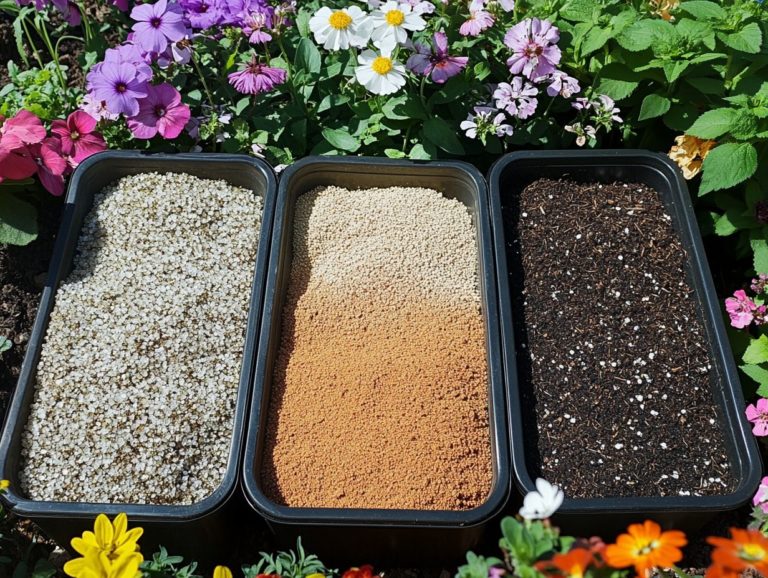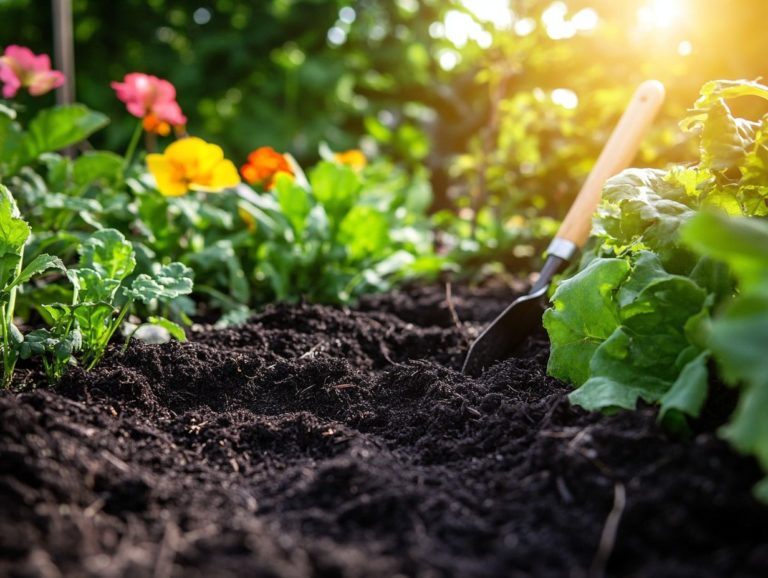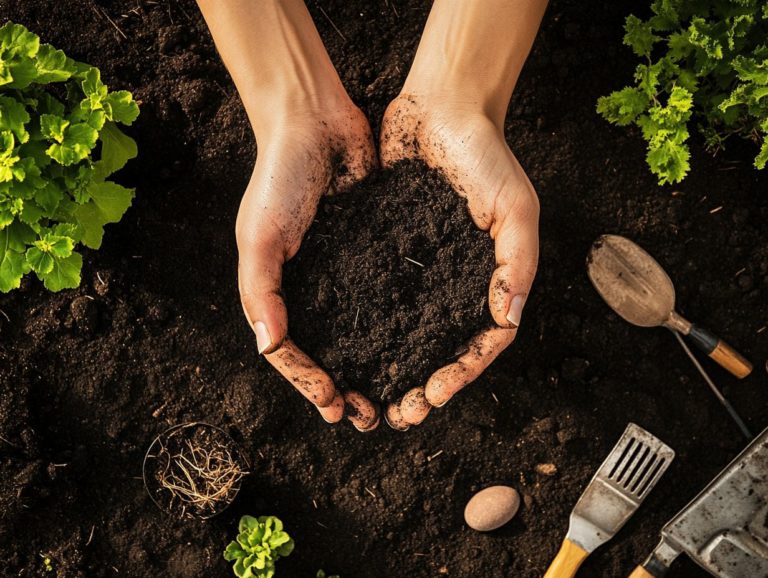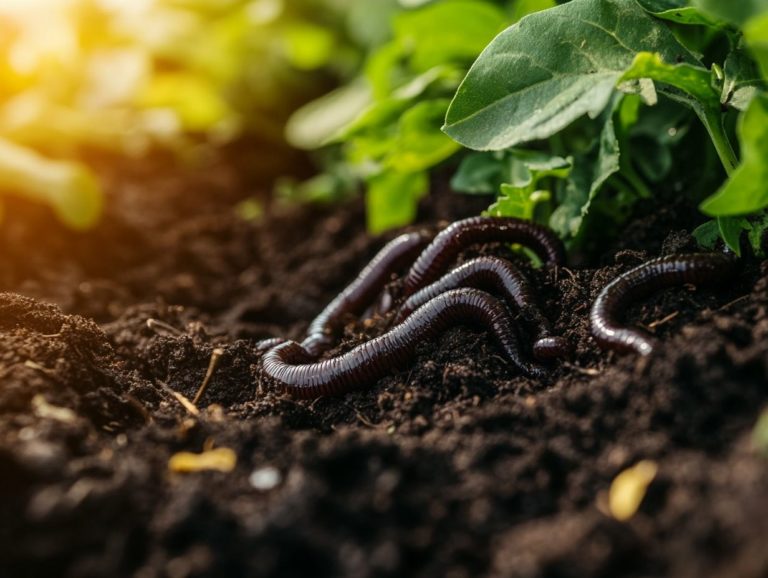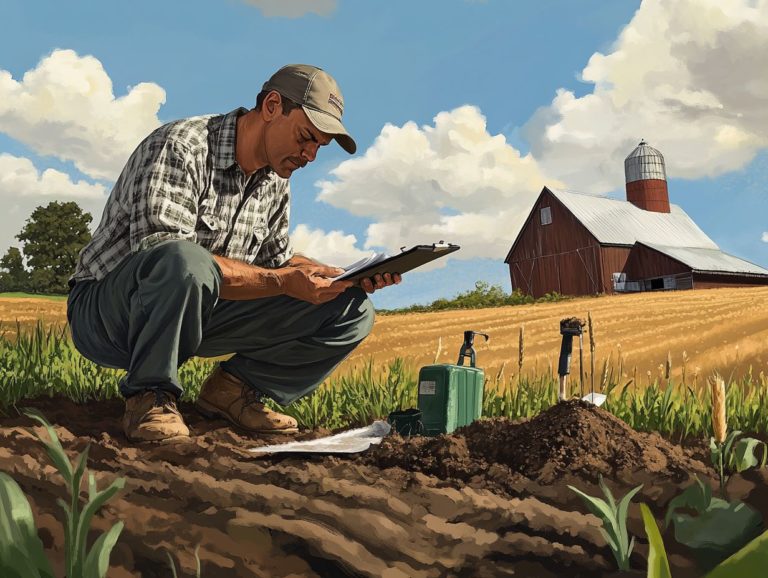5 Best Practices for Soil Restoration
Dive into the world of soil restoration! Discover how your efforts can lead to thriving farms and a healthier planet.
Soil health serves as the cornerstone of thriving ecosystems and sustainable agriculture.
As you navigate the growing environmental challenges, grasping the intricacies of soil composition and restoration becomes essential.
This article delves into five best practices for soil restoration, ranging from the incorporation of cover crops to the use of organic fertilizers.
You ll gain insight into the significance of soil restoration, the dangers of neglecting soil health, and how these practices can benefit both your farming efforts and the broader environment.
Embark on this journey toward revitalized soil and witness the transformation unfold!
Contents
- Key Takeaways:
- 1. Understand the Soil Composition
- 2. Use Sustainable Farming Practices
- 3. Incorporate Cover Crops
- 4. Rotate Crops
- 5. Use Organic Fertilizers and Amendments
- Why Is Soil Restoration Important?
- Frequently Asked Questions
- What are the 5 best practices for soil restoration?
- Why is crop rotation a best practice for soil restoration?
- How does cover cropping contribute to soil restoration?
- Why is composting essential for soil restoration?
- How does reduced tillage benefit soil restoration?
- Why are diverse plantings vital for soil restoration?
Key Takeaways:
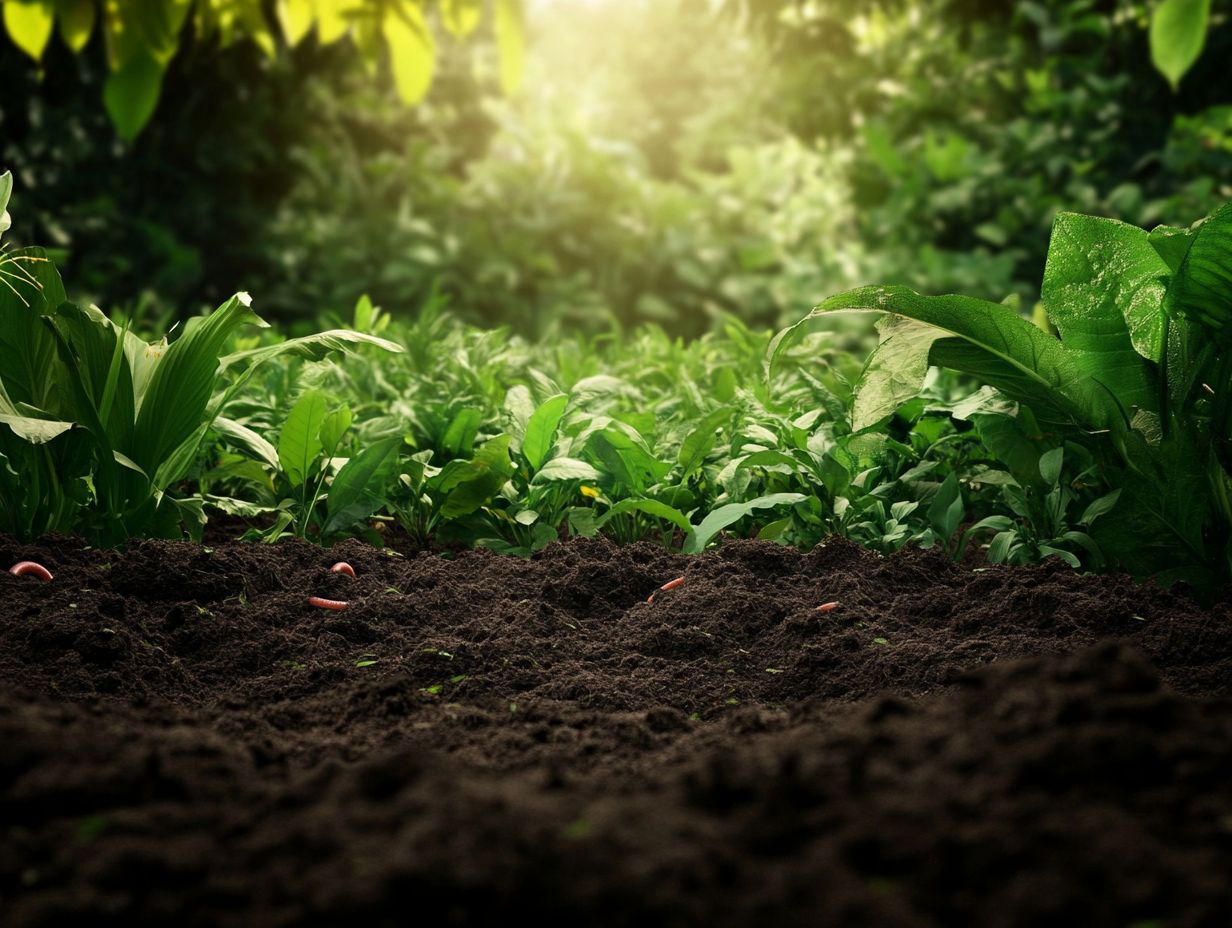
- Know what s in your soil to choose the best ways to restore it.
- Practice sustainable farming techniques to prevent further soil degradation.
- Use cover crops and change up your planting each season to improve soil health and fertility.
1. Understand the Soil Composition
Understanding soil composition is essential for your journey toward sustainable agriculture, particularly in the Mediterranean region, where the loss of different plant and animal species and soil degradation present significant hurdles amid the climate crisis.
Soil isn t just dirt; it s a living system made up of organic matter, minerals, gases, liquids, and a myriad of microorganisms all working together to cycle nutrients and maintain overall soil health.
This health is crucial for food production and ecological balance.
The mineral content including key nutrients like nitrogen, phosphorus, and potassium plays a vital role in fostering plant growth.
Meanwhile, organic matter, originating from decaying plants and animals, not only improves the soil’s structure but also enhances its ability to retain water and nutrients.
Soil microorganisms think bacteria, fungi, and protozoa are the unsung heroes in this process, breaking down organic matter to release essential nutrients for plants.
These parts come together to create healthy soil, critical for sustaining agricultural productivity, especially in the Mediterranean, where a variety of crops flourish.
By understanding and nurturing these elements, you can effectively manage your soils, boost agricultural yields, and tackle the broader environmental challenges at hand.
2. Use Sustainable Farming Practices
Sustainable farming practices are important for addressing the detrimental impacts of pollution and the loss of different plant and animal species.
They promote soil regeneration and environmental restoration while fostering food sovereignty.
By adopting regenerative agriculture techniques, you can enhance ecosystem resilience, cultivate healthier soils, and ultimately secure your yields for generations to come.
Efficient livestock management is also crucial; it improves animal welfare and reduces greenhouse gas emissions.
Incorporating biodegradable solutions into your farming practices significantly minimizes waste and enriches the soil naturally.
These holistic approaches not only preserve essential resources but also play a key role in climate change mitigation, paving the way for a more sustainable and equitable agricultural future.
3. Incorporate Cover Crops
Incorporating cover crops into your agricultural systems can greatly enhance soil health by improving nutrient cycling, boosting water retention, and increasing carbon sequestration, especially during drought conditions.
These beneficial plants come in various types legumes, grasses, and brassicas each offering its own unique advantages.
For example, legumes like clover and vetch can naturally fix nitrogen in the soil, enriching it without the need for synthetic fertilizers.
Grasses such as rye work wonders by building organic matter and suppressing pesky weeds. Brassicas, on the other hand, excel at breaking up compacted soil, enhancing aeration and drainage.
You can easily integrate these crops by planting them in the off-season, allowing them to grow and thrive without competing with your main crops.
By implementing a rotation system with diverse cover crops, you not only prevent soil erosion but also nurture a healthier soil ecosystem, paving the way for more sustainable farming practices in the long run.
Start incorporating cover crops today to boost your soil’s health!
4. Rotate Crops

Crop rotation is vital for maintaining soil health. It prevents nutrient imbalance and reduces the effects of over-cultivation.
When you alternate different crops in a specific sequence, you optimize soil fertility. This practice also disrupts pest and disease cycles that thrive in monoculture.
For instance, integrating legumes like soybeans or peas into your rotation with cereals can significantly boost nitrogen levels in the soil. Crops with deep root systems can break up compacted soil layers, leading to better water retention and root growth.
Together, these strategies can significantly boost your crop yields and create a thriving ecosystem, ensuring robust agricultural productivity for future generations.
5. Use Organic Fertilizers and Amendments
Using organic fertilizers like compost is essential. They enhance nutrient cycling and improve soil health.
Options like well-rotted manure, green manures, and biochar each offer distinct benefits for soil structure and fertility. By replenishing essential nutrients and boosting the activity of tiny organisms that help the soil stay healthy, organic fertilizers create a vibrant ecosystem.
Composting is a sustainable practice that recycles organic waste while increasing organic matter. This process aids in moisture retention and supports beneficial organisms. As these methods gain popularity, they significantly contribute to sustainable agriculture and play a vital role in restoring degraded soils.
Why Is Soil Restoration Important?
Soil restoration is crucial in tackling the climate crisis and biodiversity loss. For effective methods, consider these 5 tips for seasonal soil preparation. Healthy soils provide essential ecosystem services that support agricultural systems and maintain ecological balance.
These ecosystems form the foundation for effective agricultural practices, stabilizing the land and preventing degradation. Nurturing a diverse array of microorganisms enhances soil health, facilitates nutrient cycling, and bolsters plant resilience.
This restoration elevates long-term food production and fortifies environmental stability. Investing in soil health by exploring 5 ways to improve soil organic content contributes to sustainable growth and ensures a healthier planet for future generations.
What Are the Consequences of Neglecting Soil Health?
Neglecting soil health leads to serious consequences, including degradation, loss of biodiversity, and heightened soil pollution. These issues create a nutrient imbalance that jeopardizes food production and ecosystem stability.
Such challenges threaten crop yields and put farmers’ livelihoods at risk, with productivity potentially plummeting by as much as 50% in severely degraded areas. A recent study revealed that over 40% of the world’s arable land is affected by erosion, salinization, or compaction, posing grave implications for food security.
The decline of microbial diversity disrupts nutrient cycling and exacerbates the issue. Local ecosystems are also affected; species that depend on healthy soils for their habitats face decline, leading to diminished biodiversity and weakened resilience against climate change.
What Are the Different Methods of Soil Restoration?
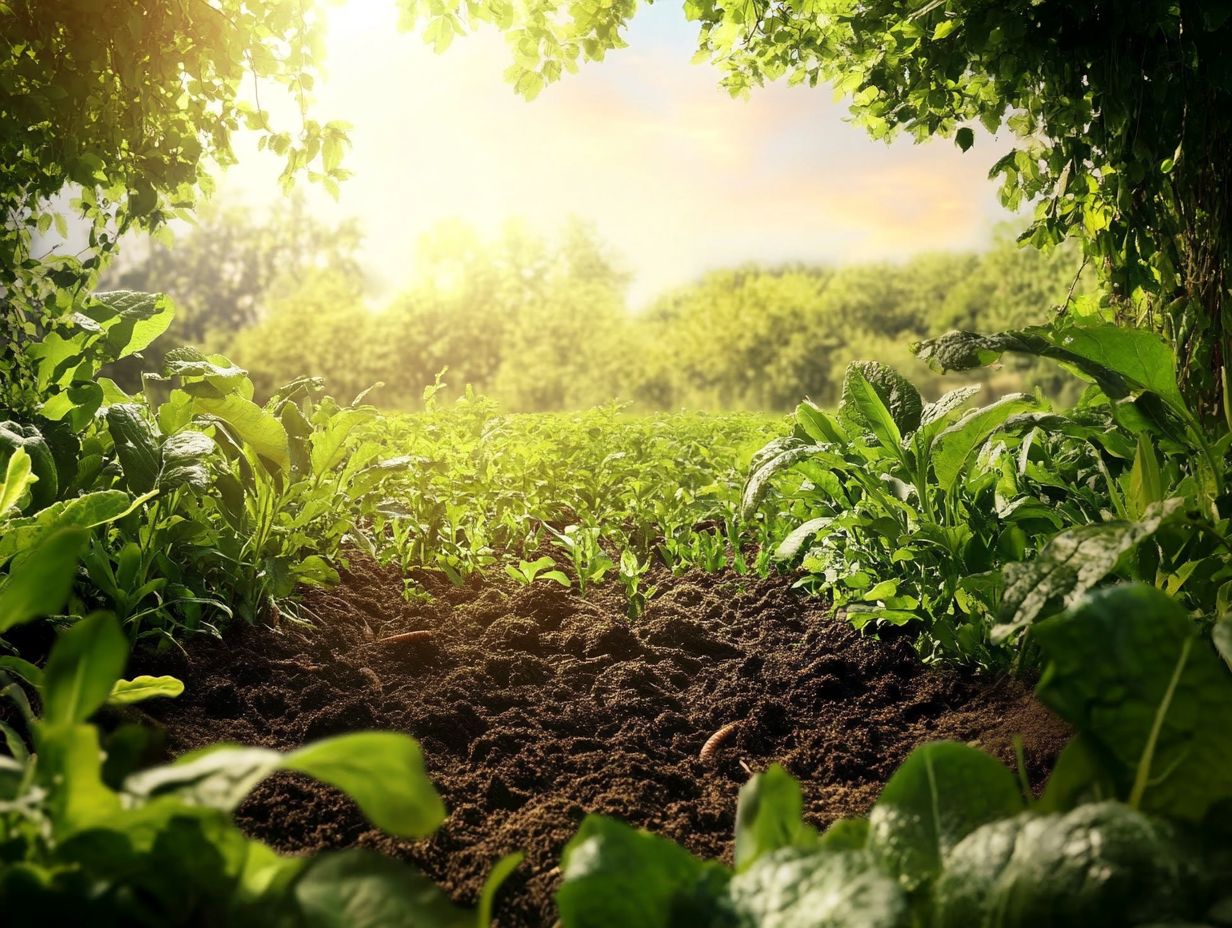
Discover the exciting methods of soil restoration available today! Various techniques have emerged, including composting, the application of organic amendments, and regenerative agriculture practices. To further enhance your efforts, explore 5 ways to reduce soil pollution that promote soil regeneration and overall health.
These techniques do more than just boost soil fertility; they are essential for reducing erosion and fostering biodiversity. Composting enriches the soil with vital nutrients. Organic amendments introduce beneficial microorganisms that promote plant growth. Regenerative agriculture emphasizes practices like crop rotation and cover cropping, nurturing resilient ecosystems.
Organizations such as CREAF and the FAO support these practices by providing education and resources to farmers and communities while championing sustainable development. Their initiatives underscore the critical role of healthy soils in combating climate change and securing food resources for generations to come.
Summary: Soil restoration methods like composting and regenerative agriculture improve health and sustainability, and learning how to implement sustainable soil practices can enhance these efforts.
How Can Soil Restoration Benefit Farmers and the Environment?
Soil restoration presents a wealth of benefits, enhancing your productivity while nurturing the environment. It supports improved food sovereignty and delivers essential ecosystem services, which are critical to both agriculture and nature. For instance, incorporating best practices for water quality improvement can further enhance these efforts.
By adopting practices like cover cropping, crop rotation, and reduced tillage, you can elevate your yields while contributing to soil health. These methods enhance biodiversity, aid in carbon sequestration capturing and storing atmospheric carbon dioxide and reduce reliance on chemical fertilizers and pesticides.
This synergy between your agricultural practices and environmental stewardship ensures long-term sustainability in farming systems, preserving precious natural resources for future generations. Participate in a sustainable cycle of health and productivity that benefits both you and the environment!
Summary: Soil restoration enhances productivity and ecosystem services, ensuring sustainability.
What Are the Challenges of Soil Restoration?
Despite its significance, soil restoration presents numerous challenges, including ongoing soil degradation, overgrazing, inadequate drainage, and increasingly severe drought conditions that impede restoration efforts.
These hurdles jeopardize the delicate balance of ecosystems and threaten food security and agricultural productivity. To tackle these complex issues, you need a deep understanding of root causes, such as unsustainable farming practices and the impacts of climate change.
Implementing effective agricultural policies can shape your restoration strategies. Promote sustainable land use, incentivize conservation practices, and support research into innovative soil management techniques, such as ways to encourage soil biodiversity, to make a significant impact. Align governmental priorities with community needs to collaboratively devise comprehensive solutions that enhance soil health and resilience.
Summary: Key challenges include soil degradation and drought; incorporating 5 must-have plants for healthy soil can enhance restoration efforts through effective policies.
How Can Individuals Contribute to Soil Restoration Efforts?
You can play a vital role in soil restoration efforts by embracing sustainable practices like composting organic waste. This improves soil health and helps reduce pollution.
Explore methods such as creating native plant gardens, which support local ecosystems and lessen reliance on harmful fertilizers. Educate yourself and others about the importance of soil health to nurture a community-wide commitment to environmental stewardship.
Get involved today! Attend workshops or participate in local cleanup events to boost awareness and inspire collective action. Each small effort whether it’s mulching, practicing responsible lawn care, or advocating for community policies that promote sustainable land use can make a substantial difference in the health of our soil and ecosystems overall.
Summary: Individuals can enhance soil health through composting, native gardens, and community involvement.
Frequently Asked Questions

- What is soil restoration? It’s the process of renewing and restoring the health of soil.
- Why is soil health important? Healthy soil supports plant growth, biodiversity, and ecosystem services.
- How can I start composting? Begin by collecting organic waste and following simple composting techniques.
What are the 5 best practices for soil restoration?
The five best practices for soil restoration are crop rotation, cover cropping, composting, reduced tillage, and diverse plantings. Implementing these techniques for sustainable soil management enhances soil health and supports beneficial microorganisms.
Why is crop rotation a best practice for soil restoration?
Crop rotation means planting various crops in a set order. This prevents soil depletion and breaks pest cycles.
How does cover cropping contribute to soil restoration?
Cover cropping involves planting specific crops to shield the soil. This prevents erosion and boosts organic matter.
Why is composting essential for soil restoration?
Composting turns organic waste into nutrient-rich soil. It enhances soil structure and helps retain water.
How does reduced tillage benefit soil restoration?
Reduced tillage minimizes soil disturbance. This preserves soil structure, reduces erosion, and promotes beneficial microorganisms.
Why are diverse plantings vital for soil restoration?
Diverse plantings enhance biodiversity and soil health. Different plants use nutrients in various ways, maintaining balance in the soil.

